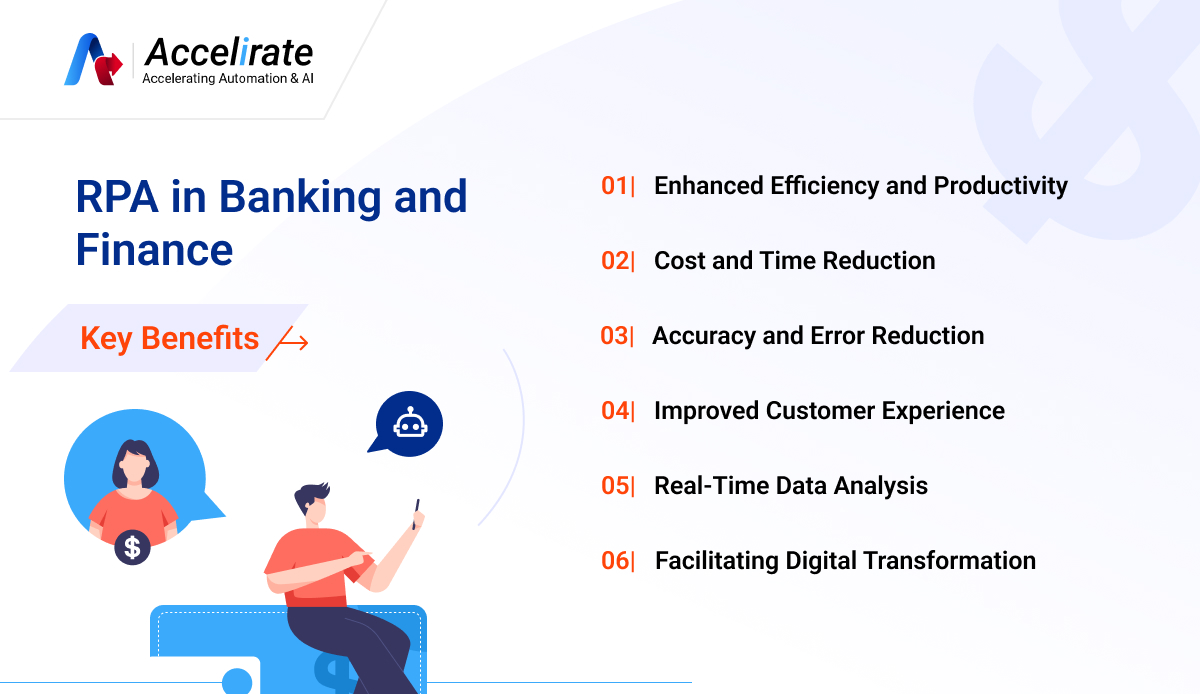RPA in banking
BLOG
11 min read
What is RPA in Banking and Finance: Use Cases, Benefits, Challenges and More
RPA implementation in banking and finance has emerged as a dominant technology. Its sustainable market and constant evolution with digital technology make it an ideal choice for adoption of RPA in banking and financial sector. With a projected market value of $1.12 billion by 2025, RPA can significantly impact these sectors through use cases like fraud detection, trade settlement, risk management, and regulatory reporting. Its ability to reduce operational costs and increase productivity make it an essential tool for banks to stay competitive and meet customer demands.
Therefore, it is the right time to leverage RPA technology in these sectors, utilizing advanced options such as AI and Hyperautomation on a large scale. However, successful implementation of automation in banking industry requires a solid strategy, execution, and careful selection of technologies to ensure seamless integration and optimal results. In this blog, we will explore some of the effective use cases, key benefits and challenges of RPA to facilitate a smooth implementation process.
The Market Share Of Banking And Finance In The Global Market
How Can You Excel in These Sectors with RPA?
As we already know, to excel in the banking and finance sectors with RPA, it's essential to have a solid strategy, careful execution, and the right technology selection. However, along with these, there are some core elements that must also be considered.
Understanding the Sector
The first and most important step is to understand how the banking and financial sectors work. The focus of both sectors is customer data. It is always better to first know about what data they process and how much data they process, followed by how much customer involvement and interaction are involved.
Understanding Customer Needs
Banking and finance are highly customer centric. One must always think about the service they provide to customers. Understanding customer requirements and expectations will provide valuable insights into where and how to implement RPA effectively. Identify customer pain points first and then find solutions that will lead to high customer satisfaction.
Identification of the Right Process
A wide range of operations is performed in banking and financial sectors for validation, management, and auditing purposes. It is an important step to identify the right process for automation by assessing its feasibility based on data volume, steps involved, and the ROI it generates. A process that effectively solves a problem, saving effort, cost, and time, is the ideal candidate for automation.
Identification of the Right Technologies
RPA is no longer limited to process automation. We now have various technologies such as hyper-automation, AI, and Mainframe automation that cover almost all areas in these sectors. These technologies offer lots of opportunities to leverage automation for different types of RPA in banking use cases.
Streamlining and Optimizing the Process
Once you identify the process and its feasibility, it's important to assess the scope for optimizing and streamlining the process, if necessary, before initiating any implementation. This will ensure quality, operational efficiency, scalability, and eliminates unnecessary inefficiencies, paving the way for automation.
Networking and Tech Skills
When you are trying to automate a task, you need to build networking connections to understand the pain points, needs, and importance of that activity. Simultaneously, to effectively solve a problem, you should possess the necessary tech skill set, problem-solving abilities, and analytical skills.
Got questions?
Talk to Our Experts Today!Key Benefits of Implementing RPA in Banking and Finance
By automating repetitive tasks and processes, RPA offers a range of benefits that enhance operational efficiency, reduce costs, and improve customer service. In fact, automation has become the need of the hour to overcome internal challenges, maximize efficiency and ensure low costs.

In banking, automation is not just limited to auditing and updating customer information. Tasks such as bank account management, credit and debit card operations, suspicious activity investigation, locking and unlocking accounts, limit breach management, managing transaction charges in a different currency, loan management, and reconciliation, customer data collation and vendor activation can also be automated. This ensures a seamless operational flow and alignment with immediate business initiatives.
Similarly, in finance, automation goes beyond auditing and invoice processing. It streamlines activities like payroll processing, financial planning and analysis, month-end and bank account closure preparation, health claim filing, intercompany reporting, currency rate updates, expense reporting, and reimbursement processes.
Let’s understand in-depth why integrating RPA to organizational workflows can bring significant changes.
Improving Efficiency and Productivity
The primary goal of RPA in banking and finance sector implementation is to enhance existing processes. During the feasibility study and streamlining phase, the focus should be on improving efficiency and increasing productivity.
Cost and Time Reduction
Cost and time are invaluable resources. Therefore, it's crucial to calculate your expenditures before implementing the solution. Reductions in cost and time benefit both customers and operations.
Accuracy and Error Reduction
When you define rules and automat tasks, the focus should be on avoiding errors that occur during manual processing and ensuring accuracy in results. Data is always critical, and in the banking and finance sector, it is much more sensitive. So, accuracy plays a vital role here.
Customer Needs and Satisfaction
The utmost importance should be on customer satisfaction with the service you provide. The end user will not be aware of how streamlined your internal operations are. The only thing they are concerned about is the end results. As such, it is extremely important to properly understand the customer’s needs and improve services that your customers would approve of.
Decision-Making On Real-Time Analysis
Real-time data analysis is one of the most important steps leading to smart and future-proof decision-making. Based on real-time data your automation should provide results and insights to make timely decisions and take actions if necessary. For this, knowledge of data analytics and visualization expertise are also critical.
Facilitating Digital Transformation
Making use of technology and tools in every stream to generate sustainable revenue, and improving efficiency and scalability can be the key that unlocks unprecedented growth. Even if the entire process is not suitable for automation you can automate parts of the process and facilitate digital transformation to future-proof your organization.
Overcoming the Challenges of Implementing RPA Technology
Let’s explore some of the common challenges faced by organizations when incorporating RPA into their workflows and strategies to overcome them effectively.
- Lack of a Defined RPA Strategy: Defining a clear automation strategy is crucial to avoid errors and ensure successful RPA implementation in banking.
- Inadequate Number of Qualified Resources: Having a skilled team is essential for leading the RPA deployment task to successful completion.
- Integration with Existing Systems: Ensuring compatibility with current systems and technologies is vital for seamless RPA integration.
- Scalability: As organizations grow, RPA systems must be able to handle increased data flow and workload volumes effectively.
- Resistance to Change from Employees: Employees may resist RPA implementation in banking and finance sector due to fear of job loss or lack of understanding about the technology's benefits.
- Security Risks: Implementing RPA on a large scale requires robust security measures to protect sensitive data and prevent unauthorized access.
- Choosing the Wrong Processes to Automate: Selecting inappropriate processes for automation can lead to inefficiencies and wasted resources.
- Lack of Adequate Knowledge About Processes: Insufficient understanding of workflows and resource sharing between projects can pose risks to successful RPA implementation.
- Maintenance Requirements: RPA systems require regular maintenance to address new scenarios, production issues, and scheduling adjustments.
- Choosing the Right RPA Solution: Selecting the most suitable RPA tool based on ease of use, integration capabilities, scalability, security features, and budget considerations is crucial for successful implementation.
Facing challenges implementing RPA in the Banking and Financial Sector?
Let's Discuss!Practical Use Cases That Can Help
Use Case 1: Suspicious Activity Investigation

Challenge
Data is highly sensitive. Suspicious activities, such as cyber-attacks, fraudulent transactions, phishing scams, and card skimming, pose significant threats to customer data security. Internal threats, such as employees providing unauthorized access for fraudulent purposes, also need to be addressed. Additionally, due to the large number of customers, some individuals may use fake identities to open accounts or obtain loans.
Solution
To investigate these activities technology can help a lot. The first step is to optimize the investigation process and then incorporate technology with each step. By using AI algorithms, one can analyze large amounts of data to identify anomalies and patterns.
Steps To Use Automation at Every Stage
Customer Complaint
Customers can register complaints via chatbot or web forms, email, or phone. Once a complaint is registered, it gets an autogenerated ticket with details like date time, customer name type of complaint, and other related information that can be captured.
Based on some pre-decided checklist, this ticket can be automatically prioritized. Later, based on certain conditions, automation can classify it as a type of fraud case and take necessary actions or assign it to the responsible person.
Monitor Transaction
Once it is identified as a fraud issue, the transaction monitoring process is enabled using machine learning and AI algorithms.
- Pattern recognition and anomalies detection: Identify patterns of transactions in the account such as a higher amount transferred to a single account, continuous transactions to one single account, and new accounts to which the amount is transferred other than normal regular accounts. Transaction amount, frequency, and location are the key variables that are being measured. Here Decision Trees, Neural Networks, Logistic Regression, Random Forest algorithms, and rule-based systems are very useful.
- Risk Scoring: It is another method where the algorithm assigns scores to each transaction based on the pattern it recognizes which indicates a higher score means a higher risk of fraud.
Customer Reporting
After each activity, customers can receive automated notifications regarding the steps taken and the next actions required. This can include automated emails and messages. If users need to take specific actions related to fraud, such as submitting documents, filling forms, or locking/unlocking cards, these processes can also be automated.
Automation in the banking sector extends to auditing and updating customer information, as well as tasks like opening and closing bank accounts, managing credit and debit cards, handling account locks/unlocks, managing limit breaches, handling transaction charges in different currencies, managing loans and reconciliations, collating customer data, and activating vendors. These tasks can be efficiently managed using RPA in banking technologies.
Verification
Verification is very important to detect whether AI ML results are correct or not.
Use Case 2: Expense Reporting and Reimbursement

Expense-related activities are very common and can be significantly improved. It contains a large set of documents processing.
Document Scanning
Processing many documents can be automated through intelligent document processing using AI algorithms such as Optical character recognition.
Document Categorization
Further to categorize and classify different documents based on some rules Natural Language Processing can be useful for accurate expense classification.
Reimbursement Approval
The approval and rejection process also can be automated, resulting faster and more efficient processing. And automatically letting your customer know about the result with the appropriate information via email, SMS notification is a smart way of providing information.
In finance, automation can be further extended to automate auditing and invoice processing, activities such as Payroll payment, financial planning, and analysis, preparing month-end and bank account closure, health claim filing, intercompany reporting, and currency rate updates are possible through automation.
Policy Enforcement
To reduce the risk of fraud decision tree algorithm can be applied and a neural network algorithm and RPA to enforce rules and policy regulations related to expense is important to avoid inaccuracy and breach.
Share your views on the most relatable RPA use case, and don't hesitate to ask our experts any questions you may have!
Talk to Us!Empowering Business Transformation with RPA
Today, RPA in banking and financial sector implementation stands as the solution to many organizational and operational challenges. By integrating various technologies such as Artificial Intelligence and Machine Learning, organizations can enhance decision-making processes. Mainframe automation further streamlines back-office tasks like data management, job scheduling, system performance monitoring, and data storage maintenance. The robotic operation center (ROC) serves as the centralized hub for managing and monitoring automation initiatives.
Automation can be applied to almost every task in some capacity, but the key lies in identifying the right use cases. When implemented effectively, RPA can revolutionize business operations and drive growth by prioritizing customer satisfaction, problem-solving, and strategic technology adoption. Partnering with a trusted RPA Service Provider can strengthen your journey with a strategic approach.


